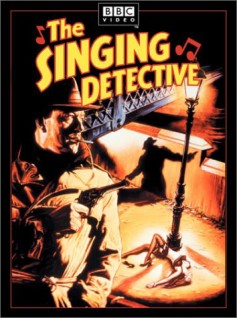|
|||
|
Philatelia.Net / Pirates. Bandits. Adventurers / Plots / The directory «Plots»«The Singing Detective»The Singing Detective is a critically acclaimed BBC television serial, written by Dennis Potter, starring Michael Gambon. Jon Amiel directed. The episodes were "Skin", "Heat", "Lovely Days", "Clues", "Pitter Patter", and "Who Done It". The serial was broadcast in the U.K. on BBC1 in 1986 on Sunday nights from November 16 to December 21 with later PBS and cable television showings in the United States. It won a Peabody Award in 1989. It ranks 20th on the British Film Institute's list of the 100 Greatest British Television Programmes, as voted by industry professionals in 2000. It was included in the 1992 Dennis Potter retrospective at the Museum of Television & Radio and became a permanent addition to the Museum's collections in New York and Los Angeles. There was co-production funding from the Australian Broadcasting Corporation. The DVD set was released 15 April 2003. The serial was adapted into a 2003 film featuring Robert Downey Jr. and Mel Gibson, with the setting altered to the United States. The story revolves around mystery writer Philip E. Marlow and his most recent hospital stay. Having reached its peak, his psoriatic arthropathy (a chronic skin and joint disease) forms lesions and sores covering his entire body, and partially cripples his hands and feet. Dennis Potter suffered from this disease himself, and wrote with a pen tied to his fist much in the same fashion Marlow does in the last episode. Although severe, Marlow's case was intentionally understated compared to Potter's real case: Potter's skin would sometimes crack and bleed. As a result of constant pain, a fever caused by the condition, and his refusal to take medication, Marlow falls into a fantasy world involving his Chandleresque novel, The Singing Detective, an escapist adventure about a detective (also named "Philip Marlow") who sings at a dance hall and takes the jobs "the guys who don't sing" won't take. The real Marlow also experiences flashbacks to his childhood in rural England, and his mother's suicide in wartime London. The rural location is presumably the Forest of Dean, Potter's birthplace and the location for filming, but this is never stated explicitly. The death of his mother is one of several recurring images in the series; Marlow uses it (whether subconsciously or not) in his murder mystery, and sometimes replaces her face with different women in his life, real and imaginary. The noir mystery, however, is never actually solved; all that is ultimately revealed is an intentionally vague plot involving smuggled Nazi war criminals and Soviet agents attempting to stop them. This perhaps reflects Marlow's view that fiction should be "all clues and no solutions." The three worlds of the hospital, the noir thriller, and wartime England often merge in Marlow's mind, resulting a fourth layer, in which character interactions that would otherwise be impossible (e.g. fictional characters interacting with non-fictional characters) occur. This is evident in that many of Marlow's friends and enemies (perceived or otherwise) are represented by characters in the novel: particularly, one of the boys from his childhood, Mark Binney, becomes conflated with Raymond, Marlow's mother's lover, and appears as the central antagonist in the "real" and noir worlds (although the "real" Binney/Finney is ultimately a fantasy as well). The use of Binney as a villain stems from an event in his early childhood where Marlow framed the young Binney for defecating on a disciplinarian elementary teacher's desk, a perverse act of vengeance for the affair Marlow has witnessed between his own mother and Binney's father. The innocent Binney is brutally beaten in front of the student body, and Marlow is lauded for telling the "truth". These events haunt Marlow, as it is revealed that the real Binney eventually ends up in a mental institution. The villainous Binney/Finney character is killed off in both realities. Some members of the cast each play several different parts: Marlow and his alter-ego, the singing detective, are both played by Gambon. Marlow as a boy is played by Lyndon Davies. Patrick Malahide plays three central characters - the contemporary Finney, who Marlow thinks is having an affair with his ex-wife, played by Janet Suzman; the imaginary Binney, a central character in the murder plot; and Raymond, a friend of Marlow's father who has an affair with his mother (Alison Steadman). Steadman plays both Marlow's mother, and the mysterious "Lili", one of the murder victims. Great Britain, 1996, 75 years of the BBC Advertising: |
|||
© 2003-2025 Dmitry Karasyuk. Idea, preparation, drawing up
|

